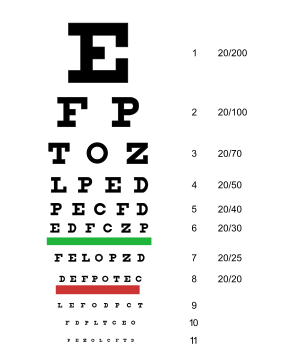This article needs more reliable medical references for verification or relies too heavily on primary sources. (December 2021) |  |
| Eye examination | |
|---|---|
 Traditional Snellen chart used for visual acuity testing | |
| MedlinePlus | 003434 |
| LOINC | 29271-4 |
An eye examination, commonly known as an eye test,[1] is a series of tests performed to assess vision and ability to focus on and discern objects. It also includes other tests and examinations pertaining to the eyes. Eye examinations are primarily performed by an optometrist, ophthalmologist, or an orthoptist. Health care professionals often recommend that all people should have periodic and thorough eye examinations as part of routine primary care, especially since many eye diseases are asymptomatic.
Eye examinations may detect potentially treatable blinding eye diseases, ocular manifestations of systemic disease, or signs of tumors or other anomalies of the brain.
A full eye examination consists of a comprehensive evaluation of medical history, followed by 8 steps of visual acuity, pupil function, extraocular muscle motility and alignment, intraocular pressure, confrontational visual fields, external examination, slit-lamp examination and fundoscopic examination through a dilated pupil.
A minimal eye examination consists of tests for visual acuity, pupil function, and extraocular muscle motility, as well as direct ophthalmoscopy through an undilated pupil.
- ^ "Free NHS eye tests and optical vouchers". National Health Service. 9 November 2020.